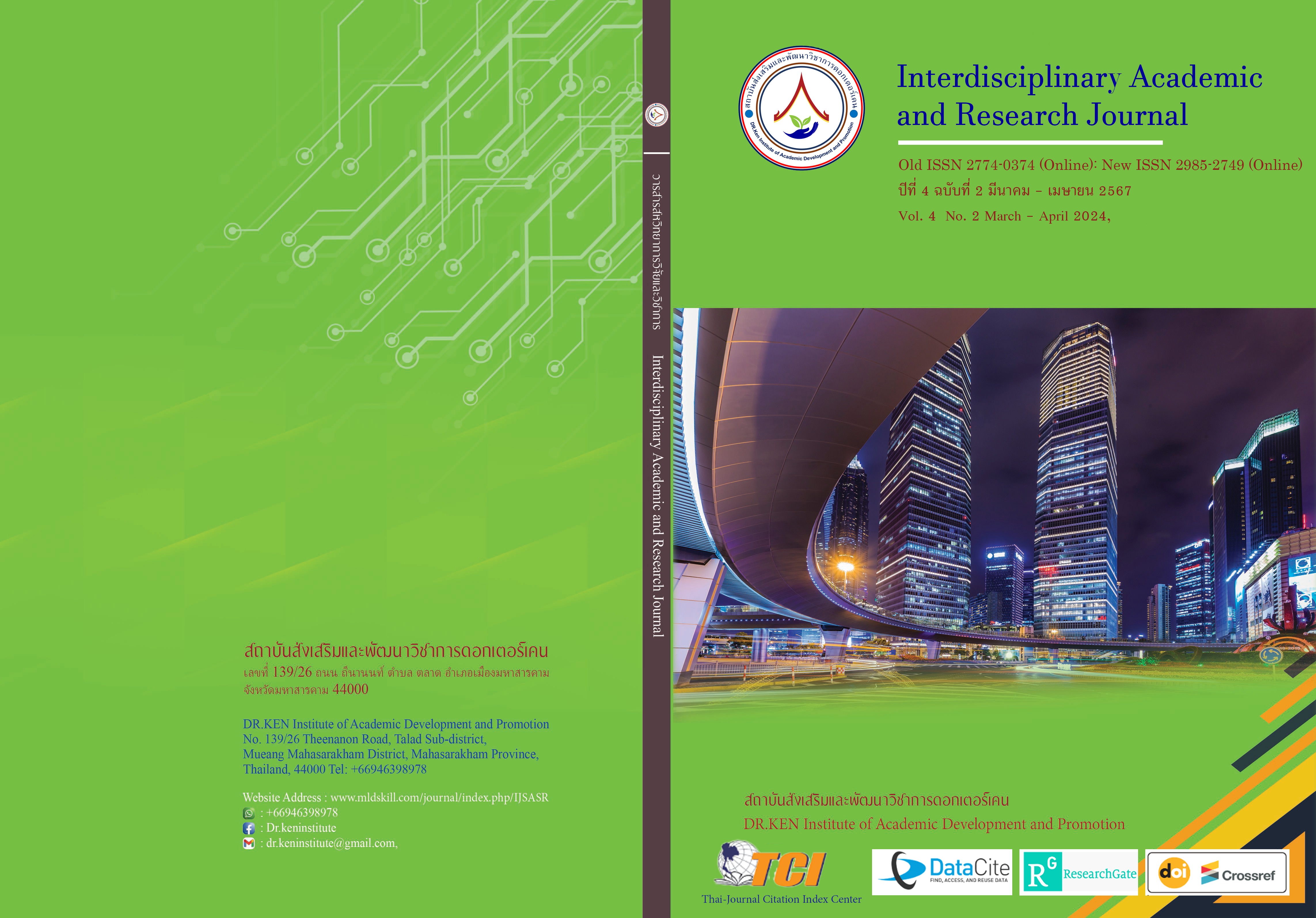The Development Evaluation of Needs in Developing Learning Lessons in the Digital Era of The Student Teaching in Faculty of Education Ramkhamhaeng University: Mixed Method
DOI:
https://doi.org/10.60027/iarj.2024.275448Keywords:
Evaluation of Needs; , Learning Lesson; , Digital EraAbstract
Background and Aims: This research aims to investigate the current state and desired conditions for the development of digital learning management among pre-service teacher interns at the Faculty of Education, Ramkhamhaeng University. The objectives of the study are threefold: (1) to examine the existing conditions and the desired state for the development of digital learning management among pre-service teacher interns; (2) to assess the essential requirements for enhancing digital learning management among pre-service teacher interns; and (3) to propose strategies for the development of digital learning management for pre-service teacher interns at the Faculty of Education, Ramkhamhaeng University.
Methodology: The research utilizes a mixed-methods approach, incorporating both quantitative and qualitative research methods. Data collection tools include questionnaires and interviews for assessing the necessary requirements for digital learning management development. Statistical analyses such as frequency distribution, percentages, mean values, standard deviations, PNIModified method, and content analysis are employed to analyze the gathered data.
Results: This research found that (1) The study found that the overall current state is high (mean = 3.99, SD = 0.49). When examined by dimension, the highest average was observed in the area of innovative technology media and learning environment organization, rated at a high level. Following closely were curriculum and course content, rated at a high level, while the lowest average was in the student dimension, also rated at a high level. The desired state overall is also high (mean = 4.45, SD = 0.48). When analyzed by dimension, the highest average was in the curriculum and course content dimension, rated at the highest level. Following this, the innovative technology media and learning environment organization dimension were also rated at a high level. The lowest average was in the student dimension, rated at a high level. (2) The essential requirements for developing digital learning management among pre-service teacher interns were examined. The dimensions of students, teachers, assessment and learning outcome measurement, learning management design, curriculum and course content, and media, technology, innovation, and learning environment organization had PNI(Modified) values of 0.141, 0.121, 0.119, 0.118, 0.113, and 0.092, respectively. (3) The development strategies for digital learning management in the digital age included: (3.1) Enhancing student skills in accessing and using various media, technology innovations, secure communication, and keeping pace with digital society trends. (3.2) Adapting teaching methods by incorporating innovative technology media to make teaching more effective. (3.3) Evaluating learning outcomes using contemporary computer programs and applications, involving students in the learning process. (3.4) Designing learning management to foster analytical thinking, diverse skills, and experiences that align with the age and interests of learners. (3.5) Developing curriculum and course content in a modern, engaging, and responsive manner under societal changes. (3.6)Utilizing and incorporating a variety of innovative media, technologies, and learning environment organization to enhance learning processes and contribute to the success of learners.
Conclusion: The study focuses on the effectiveness of key learning management aspects, such as media, technological innovations, and classroom organization. It emphasizes addressing issues related to student participation. Additionally, the study should be subject to improvement and development to enhance learning processes in the digital age. It supports learning management strategies for both students and educators, aiming to equip them with knowledge, digital skills, and innovative teaching approaches. Furthermore, curriculum development should align with adaptability to the changing educational environment and keep pace with the evolving digital landscape.
References
กระทรวงดิจิทัลเพื่อเศรษฐกิจและสังคม, สำนักงานคณะกรรมการดิจิทัลเพื่อเศรษฐกิจและสังคมแห่งชาติ. (2560). นโยบายและแผนระดับชาติว่าด้วยการพัฒนาดิจิทัลเพื่อเศรษฐกิจและสังคม (พ.ศ2561-2580). Retrieved from: https://onde.go.th/assets/portals/1/files/620425-Government%20Gazette.PDF
กระทรวงศึกษาธิการ. (2552). หลักสูตรแกนกลางการศึกษาขั้นพื้นฐาน พุทธศักราช 2551. โรงพิมพ์ชุมนุมสหกรณ์การเกษตรแห่งประเทศไทย.
กีรติ คุวสานนท์ และภาวิณี โสธายะเพ็ชร (2566) การส่งเสริมองค์ประกอบตามแนวคิดผู้เรียนเป็นสำคัญเพื่อการพัฒนาสมรรถนะของผู้เรียน. วารสารศึกษาศาสตร์ มหาวิทยาลัยศิลปากร, 21(1), 11-20.
กุลิสรา จิตรชญาวณิช. (2562). การจัดการเรียนรู้. สำนักพิมพ์จุฬาลงกรณ์มหาวิทยาลัย.
คุรุสภา. (2563). ประกาศคณะกรรมการคุรุสภา เรื่อง หลักเกณฑ์และวิธีการทดสอบและประเมินสมรรถนะทางวิชาชีพครู. (2563). ราชกิจจานุเบกษา, 136 ตอนพิเศษ(109ง) , 15-18.
จุฑามาศ แสงงาม และคณะ. (2563). การประเมินความต้องการจำเป็นเกี่ยวกับการจัดการเรียนรู้เชิงรุกของอาจารย์ คณะศึกษาศาสตร์์/ครุุศาสตร์์. วารสารครุุศาสตร์์ จุุฬาลงกรณ์์มหาวิิทยาลััย, 48(4), 59-75
บุหลัน กุลวิจิตร. (2565). การรู้ดิจิทัลของนักศึกษาระดับปริญญาตรีมหาวิทยาลัยศิลปากรวิทยาเขตพระราชวังสนามจันทร์. วารสารห้องสมุด, 66(2), 115-130.
พงษ์พัชรินทร์ พุธวัฒนะ. (2564). การจัดการเรียนรู้เพื่อพัฒนาผู้เรียนในยุคดิจิทัล. วารสารนวัตกรรมการเรียนรู้และเทคโนโลยี, 1(2), 1-11.
พรรณอร อุชุภาพ. (2561). การศึกษาและวิชาชีพครู. สำนักพิมพ์แห่งจุฬาลงกรณ์มหาวิทยาลัย.
เมษา นวลศรี และคณะ. (2564). การประเมินความต้องการจำเป็นเพื่อพัฒนาด้านการจัดการเรียนการสอนของนักศึกษามหาวิทยาลัยราชภัฏวไลยอลงกรณ์ ในพระบรมราชูปถัมภ์. Journal of Roi Kaensarn Academi, 6(6), 34-51.
วิภาพรรณ พินลา และวิภาดา พินลา. (2561). การจัดการเรียนรู้สังคมศึกษาในยุคศตวรรษที่ 21. สำนักพิมพ์แห่งจุฬาลงกรณ์มหาวิทยาลัย.
สิริมงคล สุวรรณผา. (2566). การพัฒนาตัวชี้วัดคุณลักษณะความเป็นครูมืออาชีพของบัณฑิตใหม่ คณะศึกษาศาสตร์ มหาวิทยาลัยรามคำแหง. วารสารสหวิทยาการวิจัยและวิชาการ, 3(5), 1033-1054.
สุวิมล ว่องวาณิช. (2558). การวิจัยประเมินความต้องการจำเป็น. พิมพ์ครั้งที่ 3. สำนักพิมพ์จุฬาลงกรณ์ มหาวิทยาลัย
Creswell, J.W. (2013). Research Design: Qualitative, Quantitative, and Mixed Methods Approaches. Sage Publications, Incorporated
Hough, J.B. & Duncan, J.K. (1970). Teaching: description and analysis. Addison-Wesley.
Hsu, J., Wang, Z., & Hamilton, K. (2011). Developing and Managing Digital/Technology Literacy and Effective Learning Skills in Adult Learners. International Journal of Digital Literacy and Digital Competence (IJDLDC), 2(1), 52-70.
Krejcie, R.V., & Morgan, D.W. (1970). Determining sample size for research activities. Educational and Psychological Measurement, 30, 607-610.
Mager, R.F. (1975). Preparing instructional objectives. 2nd edition. Pitman Learning.
Nugraha, S.T., Suwandi, S., Nurkamto, J., & Saddhono, K. (2018). Evaluation of e-learning in Indonesian as a foreign language. In Proceedings of the Tenth Conference on Applied Linguistics and the Second English Language Teaching and Technology Conference in collaboration with the First International Conference on Language, Literature, Culture, and Education (CONAPLIN and ICOLLITE 2017) - Literacy, Culture, and Technology in Language Pedagogy and Use, 481-486. DOI: 10.5220/0007169604810486
Downloads
Published
How to Cite
Issue
Section
License
Copyright (c) 2024 Interdisciplinary Academic and Research Journal

This work is licensed under a Creative Commons Attribution-NonCommercial-NoDerivatives 4.0 International License.
Copyright on any article in the Interdisciplinary Academic and Research Journal is retained by the author(s) under the under the Creative Commons Attribution-NonCommercial-NoDerivatives 4.0 International License. Permission to use text, content, images, etc. of publication. Any user to read, download, copy, distribute, print, search, or link to the full texts of articles, crawl them for indexing, pass them as data to software, or use them for any other lawful purpose. But do not use it for commercial use or with the intent to benefit any business.
















.png)


